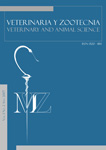Autores/as
Resumen
RESUMEN: El linfoma canino ha sido útil como modelo animal en los linfomas no Hodgkin de los humanos. En este trabajo se relatan cinco casos de linfoma maligno (linfosarcoma) en caninos que murieron por causa de la enfermedad. Los casos fueron inmunomarcados utilizando anticuerpos mono y policlonales contra antígenos de superficie de Linfocitos T y B con el fin de clasificar las neoplasias y establecer parámetros de pronóstico alrededor de esta característica celular. Dos casos fueron clasificados como originarios de las células T y ninguno originado en las células B. Se discute sobre la posibilidad de utilizar la inmunomarcación en futuros casos donde se pueda establecer criterios de pronóstico y tratamiento en los pacientes afectados por linfoma canino.
Palabras clave
Citas
Madrid, España: Interamericana - McGrawHill, 1999. p.71-101. Alizadeh, A.A.; Eisen, M.B.; Davis, R.E. et al.
Distinct types of diffuse large B-cell lymphoma identified by gene expression profiling. Nature, v.403, p.503-511, 2000.
Álvarez-Berger, F.J.; Fernández, E.A.; Aristi-Urista, G.; Chávez-Gris, G. Estudio histológico e inmunofenotípico de linfoma canino en el centro de México. Veterinaria México, v.40, n.2, p.141-155, 2009.
Arespacochaga, G.; Schwendenwein, I.; H. Weissenbock. Retrospective Study of 82 Cases of Canine Lymphoma in Austria based on the Working Formulation and Immunophenotyping. Journal Comparative Pathology, v.136, p.186-192, 2007.
Chuaqui, B.J.; González, B.S.; editores. Tumores de tejidos linforreticulares y hematopoyéticos. En: Manual de Patología general. Pontificia Universidad Católica de Chile, 20011.
Disponible en: http://escuela.med.puc.cl/publ/ patologiageneral/patol_099.html Accesado en: 15/02/2011.
Dobson, J.M.; Blackwood, L.B.; Mcinnes, E.F. et al. Prognostic Variables in Canine Multicentric Lymphosarcoma. Journal Small Animal Practice, v.42, p.377-384, 2001.
Fournel-Fleury, C.; Magnol, J.P.; Bricaire, T. Cytohistological and immunological classification of canine malignant lymphomas: comparison with human non-Hodgkin’s lymphomas. Journal of Comparative Pathology, v.117, p.35-59, 1997.
Garrett, L.D.; Thamm, D.H.; Chun, R. et al. Evaluation of a 6-month chemotherapy protocol with no maintenance therapy for dogs with lymphoma. Journal of Veterinary Internal Medicine, v.16, p.704-709, 2002.
Gavazza, A.; Lubas, G.; Valori, E.; Gugliucci, B. Retrospective surrey of malignant lymphoma cases in the dog: clinical, therapeutical and prognostic features. Veterinary Research Communications, v.32, p.291-293, 2008 (suppl.1).
Greenlee, P.G.; Filippa, D.A.; Quimby, F.W. et al. Lymphomas in dogs. A morphologic, immunologic, and clinical study. Cancer, v.66, p.480-490, 1990.
Hosoya, K.; Kisseberth, W.C.; Lord, L.K. Comparison of COAP and UW-19 protocols for dogs with multicentric lymphoma. Journal of Veterinary Internal Medicine, v.21, p.1355-1363, 2007.
Jacobs, R.M.; Messick, J.B.; Valli, V.E. Tumors of the hemolymphatic system, Tumors of domestic animals. 4.ed., Iowa, USA: State Press, 2002. 138p.
Jamadar-Shroff, V.; Papich, M.G.; Suter, S.E. Soyderived isoflavones inhibit the growth of canine lymphoid cell lines. Clinical Cancer Research, v.15, p.1269-1276, 2009.
Kaiser, H.E.; editor. Animal neoplasms: a systemic review. Neoplasms. Comparative Pathology in Animals, Plants and Man. Baltimore, USA: Williams and Wilkins, 1981. p.747-812.
MacEwen, E.G.; Hayes, A.A.; Matus, R.E.; Kurzman, I. Evaluation of some prognostic factors for advanced multicentric lymphosarcoma in the dog: 147 cases (1978-1981). Journal of the American Veterinary Medical Association, v.190, p.564-568, 1987.
Miller, A.G.; Morley, P.S.; Rao, S. et al. Anemia is associated with decreased survival time in dogs with lymphoma. Journal of Veterinary Internal Medicine, v.23, p.116-122, 2009.
Pedraza, F.J.; Schild, A.L.; Alessi, A.C. Immunohistochemical description of encephalitis in Brazilian cattle naturally infected with bovine herpes virus type 5 (BoHV5). Archivos de Medicina Veterinaria, v.40, p.69-75, 2008.
Ponce, F.; Marchal, J.P.; Magnol, V. et al. A morphologic study of 608 cases of canine malignant lymphoma in France with a focus on comparative similarities between canine and human lymphoma morphology. Veterinary Pathology, v.47, p.414-433, 2010.
Sapierzyński, R. Practical aspects of immunocytochemistry in canine lymphomas. Polish Journal of Veterinary Sciences, v.13, n.4, p.661-668, 2010.
Thomas, R.; Smith, K.C.; Gould, R. et al. Molecular Cytogenetic Analysis of a novel Highgrade Canine T-Lymphoblastic Lymphoma Demonstrating Co-expression of CD3 and CD79a Cell Markers. Chromosome Res, v.9, n.8, p.649-657, 2001.
Tranah, G.J.; Bracci, P.M.; Holly, E.A. Domestic and Farm-Animal exposures and risk of NonHodkin´s lymphoma in a population based study in the San Francisco Bay Area. Cancer epidemiology biomarkers prevention, v.17 n.9, 2008.
Uppenkamp, M.; Feller, A.C. Classification of malignant lymphoma. Onkologie, v.25, p.563- 570, 2002.
Vail, D.M.; Thamm, D.H.; Reiser, H. et al. Assessment of GS-9219 in a pet dog model of non-Hodgkin’s lymphoma. Clinical Cancer Research, v.15, p.3503-3510, 2009.
Vernau, W.; Moore, P.F. An immunophenotypic study of canine leukemias and preliminary assessment of clonality by polymerase chain reaction. Veterinary Immunology Immunopathology, v.69, p.145-164, 1999.
Vezzali, E.; Parodi, A.L.; Marcato, P.S.; Bettini, G. Histopathologic classification of 171 cases of canine and feline non-Hodgkin lymphoma according to the WHO. Veterinary and Comparative Oncology, v.8, p.38-49, 2010.

 PDF
PDF
 FLIP
FLIP










